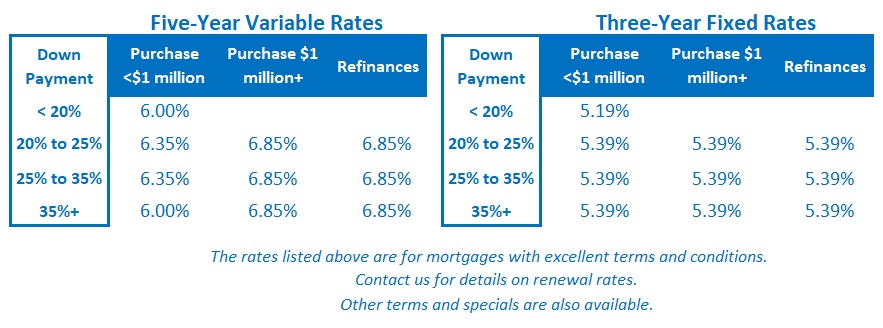Why A Recession Is Still the Most Likely Outcome
February 5, 2024Canadian Mortgage Rate Updates – Top Five Recent Posts
February 20, 2024
Last Friday Statistics Canada confirmed that our economy added an estimated 37,300 new jobs in January, well above the consensus forecast of 15,000.
This stronger-than-expected headline result supported the popular view that our economy will avoid a sharp slowdown, and it caused some market watchers to predict that it will now take longer for the Bank of Canada’s (BoC) first rate cut to materialize.
I wondered if they were reading the same report that I was.
The headline result was indeed an upside surprise, but the underlying details in the report were mixed at best.
For example, all the growth came from part-time jobs, and all the gains were in the public sector. Also, while the unemployment rate fell from 5.8% to 5.7%, that drop only occurred because our participation rate fell from 65.5% to 65.3%.
(As a reminder, the participation rate measures the percentage of working age Canadians who are either working or actively seeking employment. When it falls, it is because more Canadians have given up looking for work.)
Our January employment data were also helped by unseasonably warm temperatures last month. Statisticians make adjustments to smooth out the data when the weather gets cold, because outdoor activities, like construction, typically slow during the winter months. But when the weather is warmer than normal, those statistical adjustments are still made, artificially boosting the results.
The most encouraging news was that average hourly wage growth slowed from 5.7% to 5.3%.
Wage growth is a key area of concern for the Bank of Canada (BoC). BoC Governor Macklem has bluntly stated there is no way inflation will fall back to its 2% target when wages are growing by 5% or more and labour productivity levels are falling (which they have done for six straight quarters). Against that backdrop, even a small cooling in wage growth is a step in the right direction.
It is not a surprise that our labour market and wage growth momentum appear stronger than that of other incoming data. When our economic cycle turns, it happens in phases.
First, monetary policy is tightened.
The BoC and Fed hike their policy rates, and the bond market responds by raising the yields, which our fixed mortgage rates are priced on. These higher borrowing costs then hit the economy, but with a lag. As they do so, GDP slows, stalls, and then typically contracts.
This time around, our GDP started contracting in Q3 of last year. If Statistics Canada subsequently confirms that it did the same in Q4, for a second straight quarter, we will have met the most common definition of a recession.
Interestingly, if we measure our GDP on a per capita basis, it has already contracted for five consecutive quarters. Our economy’s recent expansion has been underpinned entirely by the massive influx of new immigrants.
The final shoe to drop before our economic cycle definitively turns will be the labour market, and we may not be as far from that as last month’s strong headline employment result would lead you to believe.
There is now clear evidence that labour-market momentum is weakening:
- Job vacancies are declining.
- Full-time jobs are being replaced with part-time positions.
- Fewer Canadians are quitting their jobs to move to better opportunities.
- Hiring is increasingly concentrated in the public sector, which is far less sensitive to the business cycle.
- An increasing number of businesses say they are forgoing hiring plans, and some are starting to lay off workers. At the same time, workers are expressing less confidence in their job security.
As employment deteriorates, consumer spending, which accounts for about 60% of our overall economic output, will slow markedly. Companies will find it harder to pass on cost increases and will instead have to cut their margins.
In summary, although last week’s headline employment number seemed solid, a closer look at the details supports my view that a marked economic slowdown is not far off.
Mortgage Selection Advice for Now
If you’re willing to pay an upfront premium and can tolerate a higher-risk option, I think five-year variable rates are well worth considering. While we can never be fully certain how things will play out, I think the BoC will start cutting its policy rate soon enough to produce the lowest available interest cost over the full term of the mortgage.
On the other hand, if you’re a more conservative borrower who is still concerned about the risk that inflation and high rates will end up proving stickier than expected, I think a three-year fixed-rate term is the best option.
The premiums required for one- and two-year fixed rates remain substantial, and while five-year fixed-rate terms come with today’s lowest rates, I worry that five years is too long to be locking in when rates are now still near their highest levels in four decades. The Bottom Line: Government of Canada bond yields followed their US Treasury equivalents higher last week, but despite that, some lenders continued to drop their fixed rates.
The Bottom Line: Government of Canada bond yields followed their US Treasury equivalents higher last week, but despite that, some lenders continued to drop their fixed rates.
I believe that was a result of two factors:
1) Lenders normalizing gross lending spreads that were wider than normal before the recent uptick in bond yields
2) More aggressive rate competition as we approach the early spring market.
Five-year variable-rate discounts were unchanged.
The bond-futures market has pushed its BoC first rate-cut bets out to June, but thus far still expects a total of four 0.25% cuts this year.
Last week’s employment headline result may have been stronger-than-expected, but I think variable-rate borrowers should be sceptical of predictions that it will have any material impact on the timing of the first BoC rate cut.







